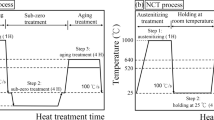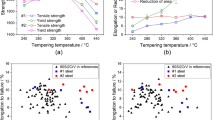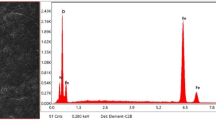Abstract
The data on the effect of carbon and nitrogen on the stacking fault energy (SFE) of austenitic steels are summarized. Threshold values of SFE characterizing the stability of austenite are given. The effective value of SFE for high-nitrogen austenitic steels is found to be 20–25 mJ/m2. At this value, these steels have the best combination of strength, ductility, and impact strength at a retained high stability of austenite to the γ–ε–α transformation during cooling and plastic deformation.







Similar content being viewed by others
REFERENCES
J. Y. Choi and W. Jin, “Strain induced martensite formation and its effect on strain hardening behavior in the cold drawn 304 austenitic stainless steels,” Scr. Mater. 36 (1), 99–104 (1997).
T. Kruml, J. Polak, and S. Degallaix, “Microstructure in 316LN stainless steel fatigued at low temperature,” Mater. Sci. Eng., A 293 (1, 2), 275–280 (2000).
G. B. Olson and M. Cohen, “A general mechanism of martensitic nucleation. Part II. FCC–BCC and other martensitic transformations,” Metall. Trans. A 7 (11), 1905–1914 (1976).
L. E. Staudhammer and L. E. Murr, “Nucleation and evolution of strain-induced martensitic (bcc) embryos and substructure in stainless steel: a transmission electron microscope study,” Acta Metall. 31, 267–274 (1983).
V. Gavriljuk and Y. Petrov, “Effect of nitrogen on the temperature dependence of the yield strength of austenitic steels,” Acta Mater., No. 46, 1157–1163 (1998).
V. Gavriljuk, Yu. Petrov, and B. Shanina, “Effect of nitrogen on the electron structure and stacking fault energy in austenitic steels,” Scr. Mater. 55 (6), 537–540 (2006).
Yu. N. Petrov, “On the electron structure of Mn–, Ni– and Cr– Ni–Mn austenite with different stacking fault energy,” Scr. Mater. 53 (10), 1201–1206 (2005).
Yu. N. Petrov, “Effect of alloying on the stacking fault energy of austenite in steel,” Metallofiz. 6 (4), 53–57 (1984).
S. Kibey, J. B. Liu, M. J. Curtis, D. D. Johnson, and H. Sehitoglu, “Effect of nitrogen on generalized stacking fault energy and stacking fault widths in high nitrogen steels,” Acta Mater. 54 (11), 2991–3001 (2006).
V. G. Gavriljuk, Yu. N. Petrov, and B. D. Shanina, “Effect of nitrogen on the electron structure and stacking fault energy in austenitic steels,” Scr. Mater. 55 (6), 537–540 (2006).
R. E. Schram and R. P. Reed, “Stacking fault energies of austenitic stainless steels,” Metall. Trans. A 6, 1345–1351 (1974).
P. J. Brofman and G. S. Ansell, “On the effect of carbon on the stacking fault energy of austenitic stainless steels,” Metall. Trans. A 9, 879–885 (1978).
T.-H. Lee, H.-Y. Ha, B. Hwang, S.-J. Kim, and E. Shin, “Effect of carbon fraction on stacking fault energy of austenitic stainless steels,” Metall. Mater. Trans. A 43, 4455–4459 (2012).
R. P. Reed and M. W. Austin, “Effect of nitrogen and carbon on FCC–HCP stability in austenitic steels,” Scr. Metall. 23 (8), 1359–1362 (1989).
O. A. Bannykh, V. M. Blinov, and N. A. Klekovkina, “Structure and mechanical properties of wires made of austenitic steels Kh16AG15N7S4 and 40Kh12G16N9MF2 for stainless springs,” Metalloved. Term. Obrab. Met., No. 5, 39–51 (1984).
Q.-X. Dai, A.-D. Wang, X.-N. Cheng, and X.-M. Luo, “Stacking fault energy of cryogenic austenitic steels,” Chinese Phys. 11 (6), 596–600 (2002).
Yu. N. Petrov and Yu. T. Ryzhkov, “Effect of alloying elements on the structural sensitivity of the stacking fault energy in stainless steels,” Metallofiz. Noveish. Tekhnol. 5, 66–70 (1983).
B. X. Huang, X. D. Wang, L. Wang, and Y. H. Rong, “Effect of nitrogen on stacking fault formation probability and mechanical properties of twinning-induced plasticity steels,” Metall. Mater. Trans. A 39, 717–724 (2008).
S. Lu, Q. M. Hub, B. Johansson, and L. Vitos, “Stacking fault energies of Mn, Co and Nb alloyed austenitic stainless steels,” Acta Mater. 59 (4), 5728–5734 (2011).
L. Bracke and M. Liebcher, “Development and characterization of high N, Ni-free austenitic steel Fe–Mn–Cr alloys, nitrogen, austenite stability, martensite,” in Proceedings of 7th International Conference on High Nitrogen Steels (Ostend, 2004), pp. 331–342.
R. Fawley, M. A. Quader, and R. A. Dodd, “Compositional effects on the deformation modes, annealing twin frequencies, and stacking fault energies of austenitic stainless steels,” TMS-AIME 242, 771 (1968).
P. R. Swann, “Dislocation substructure vs. transgranular stress corrosion susceptibility of single phase alloys,” Corrosion 19 (3), 102–114 (1963).
D. Dulieu and J. Nutting, “Stacking fault energy of Fe–Cr–Ni alloys,” in Metallurgical Developments in High Alloy Steels: Special Report 86 Iron and Steel Institute (London, 1964), pp. 140–145.
Yu. N. Petrov, Defects and Diffusionless Transformation in Steel (Naukova Dumka, Kiev, 1978).
M. Fujikura and K. Takada, “Effects of chemical compositions on the properties of austenitic manganese steels for nonmagnetic applications,” Trans. Iron Steel Inst. Japan, No. 15, 464 (1975).
T. H. Lee, C. S. Oh, and S. J. Kim, “Effects of nitrogen on deformation-induced martensitic transformation in metastable austenitic Fe–18Cr–10Mn–N steels,” Scr. Mater., No. 58, 110–113 (2008).
I. Karaman, H. Sehitoglu, H. J. Maier, and Y. I. Chumlyakova, “Competing mechanisms and modeling of deformation in austenitic stainless steel single crystals with and without nitrogen,” Acta Mater. 49 (19), 3919–3933 (2001).
T.-H. Lee, E. Shin, C. S. Oh, H. Y. Ha, and S. J. Kim, “Correlation between stacking fault energy and deformation microstructure in high-interstitial-alloyed austenitic steels,” Acta Mater. 58 (8), 3173–3186 (2010).
G. Saller, K. Spiradek-Hahn, C. Scheu, and H. Clemens, “Microstructural evolution of Cr–Mn–N austenitic steels during cold work hardening,” Mater. Sci. Eng., A 427 (1, 2), 246–254 (2006).
L. Bracke, G. Mertens, J. Penning, B. C. De Cooman, M. Liebeherr, and N. Akdut, “Influence of phase transformations on the mechanical properties of high-strength austenitic Fe–Mn–Cr steel,” Metall. Mater. Trans. A 37, 307–317 (2006).
S. Kibey and J. B. Liu, “Effect of nitrogen on generalized stacking fault energy and stacking fault widths in high nitrogen steels,” Acta Mater. 54 (11), 2991–3001 (2006).
L. Bracke, J. Penning, and N. Akdut, “The influence of Cr and N additions on the mechanical properties of FeMnC steels,” Metall. Mater. Trans. A 38 (3), 520–528 (2007).
P. Müllner, C. Solenthaler, P. Uggowitzer, and M. O. Speidel, “On the effect of nitrogen on the dislocation structure of austenitic stainless steel,” Mater. Sci. Eng. A 164 (1, 2), 164–169 (1993).
R. E. Stoltz and J. B. Vander Sande, “The effect of nitrogen on stacking fault energy of Fe–Ni–Cr–Mn steels,” Metall. Trans. A 11, 1033–1037 (1980).
R. Banov, Materialoznanie Tekhnol., No. 4, 50–57 (1977).
L. M. Kaputkina, V. V. Sumin, and K. O. Bazaleeva, “Austenite stability and stacking faults in nitrogen-bearing steels,” Materialoved., No. 4, 38–42 (2000).
M. Ojima, Y. Adachi, Y. Tomota, Y. Katada, Y. Kaneko, K. Kuroda, and H. Saka, “Weak beam TEM study on stacking fault energy of high nitrogen steels,” Steel Res. Int. 80 (7), 477–481 (2009).
V. G. Gavriljuk, B. D. Shanina, and H. Berns, “Ab initio development of a high-strength corrosion-resistant austenitic steel,” Acta Mater. 56, 5071–5082 (2008).
J. Nakano, “A thermo-mechanical correlation with driving forces for hcp martensite and twin formations in the Fe–Mn–C system exhibiting multicomposition sets,” Sci. Technol. Adv. Mater. 14 (1), 203–207 (2013).
T.-H. Lee, H. Y. Ha, B. Hwang, S. J. Kim, and E. Shin, “Effect of carbon fraction on stacking fault energy of austenitic stainless steels,” Metall. Mater. Trans. A 43, 4455–4459 (2012).
V. I. Konop-Lyashko, “Relation between the parameters of deformation-induced austenite decomposition and the mechanical properties of Cr–Mn unstable steels,” Metally, No. 6, 143–147 (1977).
L. Mosecker and A. Saeed-Akbari, “Nitrogen in chromium–manganese stainless steels are view on the evolution of stacking fault energy by computational thermodynamics,” Sci. Technol. Adv. Mater. 14, Art. 033001 (2013).
S. Allains, J. P. Chateau, and S. Bouaziz, “Correlations between the calculated stacking fault energy and the plasticity mechanisms in Fe–Mn–C alloys,” Mater. Sci. Eng., A 387–389, 158–162 (2004).
L. Remy and A. Pineau, “Twinning and strain-induced F.C.C.–H.C.P. transformation in the Fe–Mn–Cr–C system,” Mater. Sci. Eng. 28 (1), 99–107 (1977).
I. O. Bannykh, “Structural features and prospects of using high-nitrogen austenitic steels,” Metalloved. Term. Obrab. Met., No. 5, 22–29 (2019).
M. A. Shtremel’, Strength of Alloys. Part 1. Lattice Defects (ID MISiS, Moscow, 1999).
D. T. Lienwellyn, “Work hardening effects in austenitic stainless steel,” Mater. Sci. Technol. 13, 389–400 (1997).
T. Takemoto, “Effect of alloying elements of mechanical and magnetic properties of Cr–Ni austenitic stainless steel at cryogenic temperature,” Trans. ISIJ 28, 965–971 (1988).
T. Masumura and N. Nakada, “The difference in thermal and mechanical stabilities of austenite between carbon- and nitrogen-added metastable austenitic stainless steels,” Acta Mater. 84, 330–338 (2015).
Funding
This work was carried out within the framework of state task no. 076-00328-21-00 of the Ministry of Education and Science of the Russian Federation.
Author information
Authors and Affiliations
Corresponding author
Ethics declarations
The authors declare that they have no conflicts of interest.
Additional information
Translated by K. Shakhlevich
Rights and permissions
About this article
Cite this article
Blinov, V.M., Glezer, A.M., Bannykh, I.O. et al. Effect of Carbon and Nitrogen on the Stacking Fault Energy in Austenitic Steels. Russ. Metall. 2022, 347–354 (2022). https://doi.org/10.1134/S0036029522040061
Received:
Revised:
Accepted:
Published:
Issue Date:
DOI: https://doi.org/10.1134/S0036029522040061




